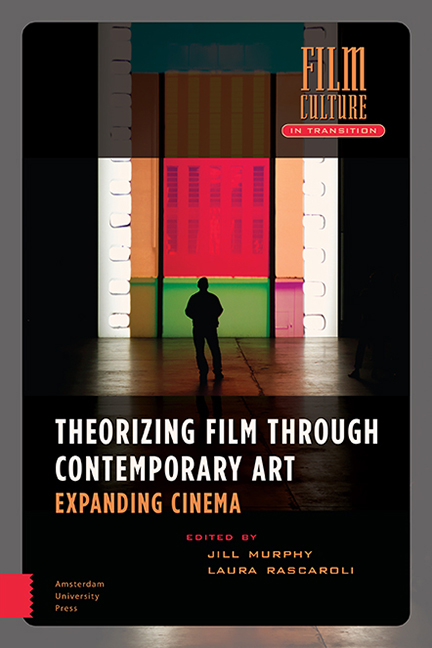Book contents
- Frontmater
- Dedication
- Contents
- List of Illustrations
- Acknowledgments
- Foreword: Courtesy of the Artists
- Introduction: On Cinema Expanding
- Part One Materialities
- 1 Cinema as (In)Visible Object; Looking, Making, and Remaking
- 2 Objects in Time; Artefacts in Artists’ Moving Image
- 3 Materializing the Body of the Actor; Labour, Memory, and Storage
- 4 How to Spell ‘Film’; Gibson + Recoder’s Alphabet of Projection
- Part Two Immaterialities
- 5 The Magic of Shadows; Distancing and Exposure in William Kentridge’s More Sweetly Play the Dance
- 6 Douglas Gordon and the Gallery of the Mind
- 7 A Throw of the Dice Will Never Abolish Chance; Tacita Dean’s Section Cinema (Homage to Marcel Broodthaers)
- Part Three Temporalities
- 8 The Photo-Filmic Diorama
- 9 The Cinematic Dispositif and Its Ghost; Sugimoto’s Theaters
- 10 Time/Frame: On Cinematic Duration
- Part Four The Futures of the Image
- 11 Interactivity without Control; David OReilly’s Everything (2017) and the Representation of Totality
- 12 Post-Cinematic Unframing
- 13 Absolute Immanence
- Index
2 - Objects in Time; Artefacts in Artists’ Moving Image
Published online by Cambridge University Press: 23 June 2021
- Frontmater
- Dedication
- Contents
- List of Illustrations
- Acknowledgments
- Foreword: Courtesy of the Artists
- Introduction: On Cinema Expanding
- Part One Materialities
- 1 Cinema as (In)Visible Object; Looking, Making, and Remaking
- 2 Objects in Time; Artefacts in Artists’ Moving Image
- 3 Materializing the Body of the Actor; Labour, Memory, and Storage
- 4 How to Spell ‘Film’; Gibson + Recoder’s Alphabet of Projection
- Part Two Immaterialities
- 5 The Magic of Shadows; Distancing and Exposure in William Kentridge’s More Sweetly Play the Dance
- 6 Douglas Gordon and the Gallery of the Mind
- 7 A Throw of the Dice Will Never Abolish Chance; Tacita Dean’s Section Cinema (Homage to Marcel Broodthaers)
- Part Three Temporalities
- 8 The Photo-Filmic Diorama
- 9 The Cinematic Dispositif and Its Ghost; Sugimoto’s Theaters
- 10 Time/Frame: On Cinematic Duration
- Part Four The Futures of the Image
- 11 Interactivity without Control; David OReilly’s Everything (2017) and the Representation of Totality
- 12 Post-Cinematic Unframing
- 13 Absolute Immanence
- Index
Summary
Abstract
As artists’ films have become more common in museums, artists have begun to film the museum and its objects with increasing frequency. The artists’ museum film opens up a dialogue between the moving image and the museum object, in which the medium's capacity to preserve and remodel time resonates with the object's power as a repository of past time. Through two examples, Tacita Dean's Day for Night (2009) and Elizabeth Price's A Restoration (2016), this essay explores the ways that these artists’ understanding of the temporalities of analogue film and digital video underpin their poetic expression of the temporality of objects. Rather than dematerializing its objects, the museum film is rematerialized by them, through the encounter between their specific temporalities.
Keywords: Museum film, indexicality, materiality, temporality, Tacita Dean, Elizabeth Price
In his well-known essay ‘On the Museum's Ruins’, Douglas Crimp offers a provocative criticism of André Malraux's Museum Without Walls:
Malraux makes a fatal error near the end of his Museum: he admits within its pages the very thing that had constituted its homogeneity; that thing is, of course, photography. So long as photography was merely a vehicle by which art objects entered the imaginary museum, a certain coherence obtained. But once photography itself enters, an object among others, heterogeneity is reestablished at the heart of the museum; its pretentions of knowledge are doomed.
Something similar has happened with artists’ film, but in reverse: having been admitted to the museum, artists have begun filming there. To name a few, films have been made in museums and galleries by Isaac Julien (Baltimore, 2000; Vagabondia, 2003), Gerard Byrne (A Thing Is a Hole in a Thing It Is Not, 2010), Fiona Tan (Inventory, 2012), Tacita Dean (Section Cinema, 2002; Darmstädter Werkblock, 2007), Heinz Emigholz (Zwei Museen, 2013), and James Benning (Natural History, 2013). Maya Deren's Witch's Cradle (1943) is an early precursor of the genre. A broader history of the museum in art cinema would include Les Statues meurent aussi (Statues Also Die, Alain Resnais and Chris Marker, 1953), Russkiy kovcheg (Russian Ark, Alexander Sokurov, 2002), and Museum Hours (Jem Cohen, 2012).
- Type
- Chapter
- Information
- Theorizing Film Through Contemporary ArtExpanding Cinema, pp. 69 - 82Publisher: Amsterdam University PressPrint publication year: 2020



